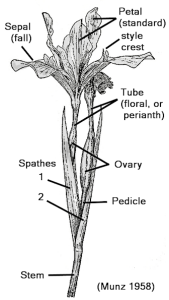Which Species?
To identify wild plants and animals, you need good keys, descriptions, drawings, maps and accurate reference photographs. An exceptionally helpful resource is the online galleries of iNaturalist, and naturalist-photographers like Ron Parsons, Mary Gerritsen, Eric Hunt and Tom Chism who know the PCI species well and have identified them correctly.
Keep in mind that every population has spent thousands of generations adapting to the conditions of its place on Earth. Its members can often be distinguished from close relatives—even those of the same species—which live farther away. Note too that one individual may not be typical of the larger population.
Most species fall into one of two groups, according to a couple of easily seen flower features. The four species somewhat outside these two groups can be identified by their own unique characteristics.
Knowing where a plant lives also helps narrow the choices.Flower color is usually helpful, although most species have several color varieties, and two species show a full range of flower colors: cream and yellow to rose, violet, lavender and deep purple. All species have white flowers as a color variant.
Victor A. Cohen’s “Guide to the Pacific Coast Irises” includes a series of very helpful drawings. These drawings illustrate the outstanding characteristics of each species.
THE THREE MAIN GROUPS:
Two key features which are helpful in determining species are the floral tube length and the open or closed position of the spathes.

Perianth tube length
Five long-tube species have perianth or floral tubes between the ovary and petals which measure between 1½ and 3½ inches or more in length.
A second group of three species has short floral tubes measuring less than one inch long.
Four unique species have intermediate length floral tubes and are identified by other features.
Spathe position
All PCI have a pair of spathes or leaf-like structures (bracts) on the stalk just below the ovary that either enclose and protect the ovary (long-tube group), or separate outward away from the stem, leaving the ovary exposed (short-tube group).
The four unique species somewhat outside the two main groups have their own characteristic spathe arrangement.
Long-tube species: Bowl-tube iris (I. macrosiphon), Fernald’s iris (I. fernaldii), Purdy’s iris (I. purdyi), Yellow-leaf iris (I. chrysophylla), Shasta iris (I. tenuissima
Short-tube species: Sierra iris (I. hartwegii), Tough-leaf iris (I. tenax), Munz’s iris (I. munzii)
Unique species: Douglas iris (Iris douglasiana), Siskiyou iris (I. bracteata), Golden iris (I. innominata), Thompson’s iris (I. thompsonii)
A BASIC IDENTIFICATION KEY
We provide here aSIMPLIFIED KEY to help get you started identifying wild Pacifica iris. Keys like thiscannot be relied upon to identify all wild or nursery-bred hybrid individuals; there is simply too much variation within each species, and with every hybrid.
Keys used to identify the twelve PCI species were historically based on one put together by Lee Lenz in his report, “A Revision of the Pacific Coast Iris.” An updated key is available in The Jepson Manual. We include an updated PCI-focused key to download(insert link to pdf).
THE PROBLEM: ABUNDANT WILD HYBRIDS
The main difficulty in identifying wild Pacific Coast iris is caused by their willingness to cross pollinate whenever their ranges overlap. The twelve species are easy to describe based on their unique features, but individual wild plants may prove difficult or impossible to assign to one of those species.
If your iris comes from a place where the ranges of two or three or four different species overlap (or if it was bred in a nursery), it may be a hybrid, with the blended features of multiple parent species.
THE OTHER NEW WORLD NATIVE IRIS
With three exceptions, the only wild irises in the western continental United States are members of theCalifornicae series. Those other western species areIris tenuis, I. missouriensis andI. longipetala.
The following is the full list of North American irises, by Iris Series. The other seven beardless iris groups, with more than a dozen species, naturally growing wild in North America, are:
- Evansia series:Iris tenuis (western Oregon),Iris cristata (southeastern & central U.S.), andIris lacustris (Great Lakes region).
- Longipetalae series:Iris missouriensis (Rocky & Sierra Nevada mountains),Iris longipetala (lowland western California).
- Hexagonae series: (all in the lower & middle Mississippi Basin) –Iris fulva,Iris brevicaulis,Iris giganticaerulea, Iris hexagonae, andIris nelsonii.
- Laevigatae series:Iris versicolor (New Brunswick to Georgia), andIris virginica (Indiana to Louisiana).
- Prismaticae series:Iris prismatica (Maine to the Carolinas).
- Tripetalae series:Iris setosa (northern Asia, Alaska, eastern Canada & Maine),Iris tridentata (Florida, Tennessee, the Carolinas).
- Vernae series: Iris vernae (Kentucky & Georgia).
